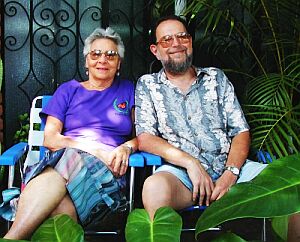
|

|
Thrown together by circumstances, they must have seen some good in each other, for they continued to talk and play together until in May of 1996, when Stan moved in to Diana's apartment. Their first collaboration was when Diana agreed to buy a telephone, and Stan agreed to pay the monthly phone bills. Everything on these pages stems from that collaboration, for without easy phone access and a local internet service (which actually came a few months later), Stan would still be faxing monthly articles to a neighborhood newspaper in Minneapolis, and Diana would not be doing e-mail, or publishing pictures on the Web.
Being mature folk when they met, they weren't about to change their habits and their tastes too much. Fortunately, there is enough to agree about that they have managed to forge a pleasant and rewarding life together in their adopted community. Travel is big for both of them, as is food, politics, music and reading. They spend a small part of every year in California, where Diana's grandchildren (and most of her children) live; where she has a small house in the foothills below Sequoia National Park; and where they both have many friends in the San Francisco Bay area. Most years they and their pal Dan travel to other parts of Mexico, or abroad, for anywhere from one to three months. Like all married couples, they do their share of bickering, but nobody but them takes it very seriously.
The house they are living in is their second since they met, and the first they moved into as a couple. It is located in the center of Oaxaca, just 5 blocks from the Zócalo. Part of a vast private property that combines commercial frontage with interior living spaces, it is deep into the middle of the block, and has its own private patio. In 2000, for the first time, they brought a vehicle down, a 1986 Datsun pickup that runs like a top despite the 206,000 miles it has on its odometer.
Stan and Diana do some volunteer work. Where, depends largely on which agency's wheel is squeaking the loudest at the moment. One thing they both agree on is that they will not spend their time helping any agency whose personnel are not mostly Mexican, preferably local Oaxaqueños, and whose decisions are not made in some representative way by the people that they serve.
They spend a lot of time around the Zócalo, where they can be seen regularly, around one p.m., when they are in town. There, they meet their friends, read their mail, buy the newspaper, and watch the never-ending scene passing by.